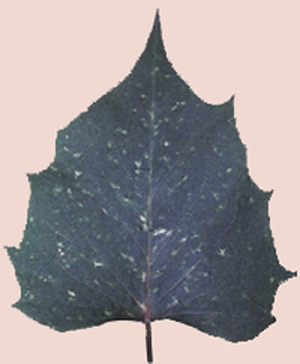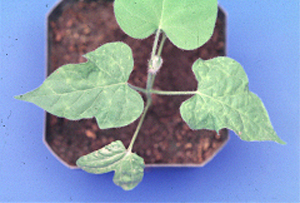|
|
Kingdom |
Virus |
|
Family |
Unknown |
|
Genus |
Unknown |
Reported in several countries. Crop losses are unknown.
SPCFV has been detected in plants from Peru, Japan, China, Cuba, Panama,
Bolivia, Colombia, Brazil, Uganda, Philippines, Indonesia, Egypt and India.
Symptoms vary with cultivar. Chlorotic flecks (fine chlorotic spots) or
symptomless infections are common.
The virus has filamentous particles around 750-800 x 12 nm
with a capsid polypeptide of Mr 34.5 KD. SPCFV is not serologically
related to other filamentous viruses from sweetpotato and potato.
No inclusion bodies ("pinwheels") have been
observed in cells of Ipomoea nil infected with SPCFV, but only
cytological alterations (hypertrophy of chloroplasts). According to serological
tests, some strains of SPCFV seem to occur.
The vector of SPCFV is unknown. It does not appear to be
transmitted by Myzus persicae nor by the botanical seed of I. nil
and I. setosa.
The only known natural host of SPCFV is Ipomoea batatas.
In the laboratory, SPCFV infects species in the
Convolvulaceae and Chenopodiaceae families. Chenopodium murale, C. quinoa,
Ipomoea nil and I. setosa are susceptible.
Regulatory control
International exchange of virus-free germplasm.
Cultural control
Use of healthy planting materials.
Host-plant resistance
Some genotypes from CIP's germplasm collection showed resistance to SPCFV
after graft-inoculation with infected I. nil scions.
Fuentes, S. and Salazar, .LF. 1992. Identification of a new
sweetpotato virus. Fitopatologia 27: 49 (Abstr. in Spanish).
Gibson, R.W., Mwanga, R.O.M., Kasule, S., Impembe, I., and
Carey, E.E. 1997. Apparent absence of viruses in most symptomless field-grown
sweetpotato in Uganda. Ann. appl. Biol. 130: 481-490.
Pozzer, L., Dussi, A.N., Silva, J.B.C., and Kitajima, E.W.
1993. Viruses detection of CNPH sweetpotato germplasm collection. Fitopatol.
bras. 18 (suplement): 289 (Abstr. in Portugese).
Usugi,
T., Nakano, M., Shinkai, A., and Hayashi, T. 1991. Three filamentous viruses
isolated from sweetpotato in Japan. Ann. Phytopathol. Soc. Japan 57: 512-521.
Contributed
by: Segundo
Fuentes and Luis Salazar
|
Taxonomy
Economic
importance
Geographical
distribution
Symptoms
Morphology
Ecology
Host
range
Management
References

Chlorotic
flecks on leaf infected with SPCFV and SPFMV (S. Fuentes & L. Salazar).

Ipomoea
nil infected with SPCFV showing
chlorotic fine spots and vein clearing,
present on the first and second true leaves (S. Fuentes & L. Salazar). |

